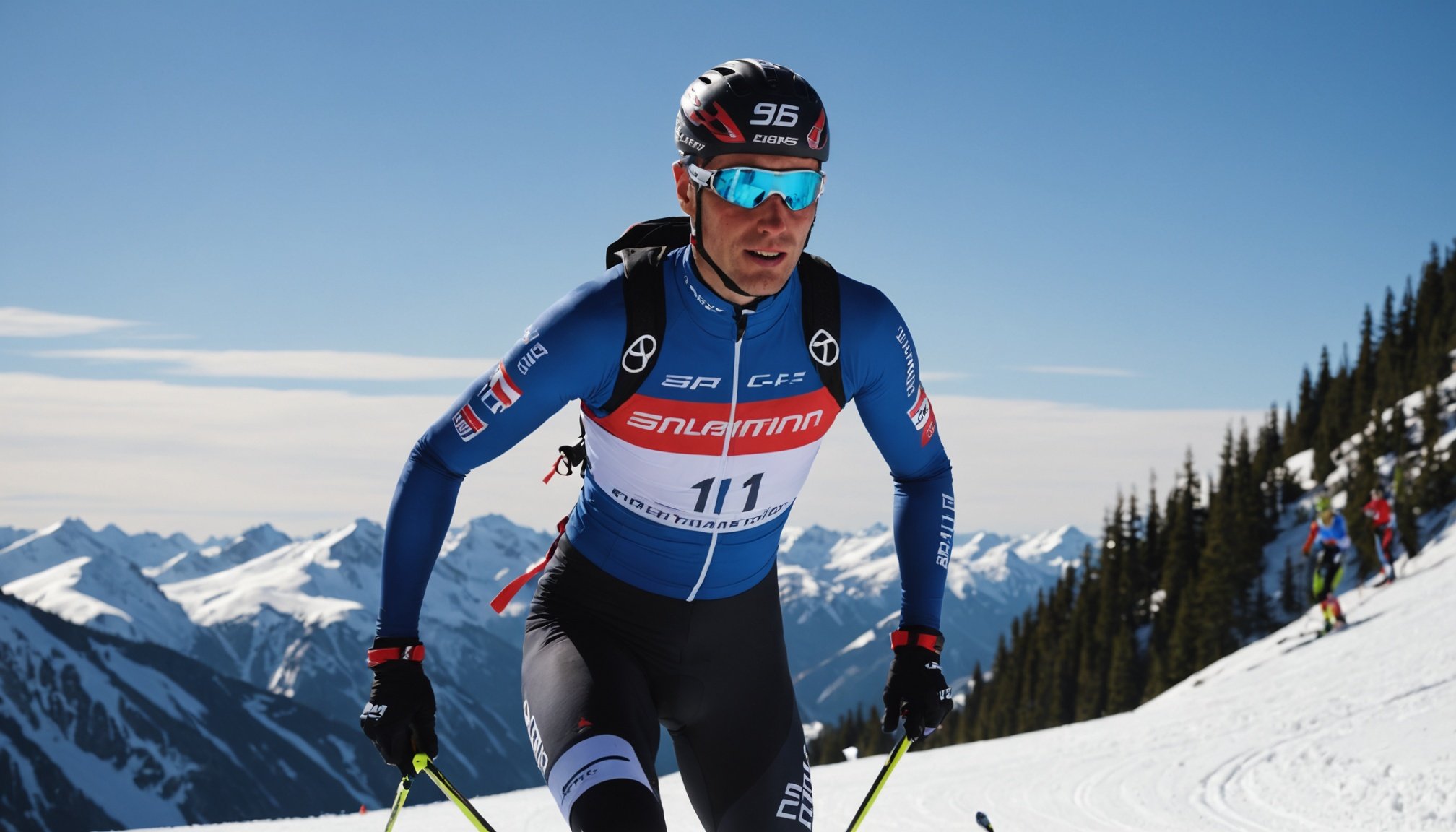How Elevation Influences Biathlete Performance: Unpacking the Effects of Altitude
When it comes to biathlon, a sport that combines cross-country skiing and target shooting, the environment in which athletes compete can significantly impact their performance. One of the most critical environmental factors is elevation, or altitude. In this article, we will delve into the effects of altitude on biathlete performance, exploring the physiological, psychological, and practical implications.
Physiological Impacts of Altitude on Biathletes
Oxygen Levels and Performance
At higher altitudes, the air pressure is lower, which means there is less oxygen available for athletes to breathe. This reduction in oxygen levels can drastically affect an athlete’s performance. Here are some key physiological changes that occur at high altitude:
Have you seen this : Mastering Underwater Breath Control: Tips for Synchronized Swimmers
- Reduced Oxygen Intake: Lower oxygen levels mean that the body has to work harder to deliver oxygen to the muscles. This can lead to decreased endurance and increased fatigue.
- Increased Heart Rate: To compensate for the lower oxygen levels, the heart rate increases to pump more blood to the muscles. This can be particularly challenging during intense activities like cross-country skiing.
- Dehydration: High-altitude environments often have lower humidity, leading to increased fluid loss through respiration and sweating. Dehydration can further exacerbate the effects of altitude on performance.
Specific Physiological Changes in Biathletes
Biathletes, who engage in both high-intensity skiing and precise shooting, face unique challenges at high altitude. Here are some specific physiological changes they might experience:
- Muscle Fatigue: The lack of oxygen can lead to quicker muscle fatigue, especially in the legs, which are crucial for skiing. This fatigue can affect the athlete’s technique and overall performance.
- Respiratory Strain: The increased respiratory rate to compensate for lower oxygen levels can put additional strain on the respiratory system, potentially leading to respiratory distress.
Psychological and Mental Impacts
Stress and Adaptation
Competing at high altitude is not just a physical challenge but also a psychological one. Here are some ways altitude can affect an athlete’s mental state:
Also to see : Enhancing Strength and Flexibility in Competitive Archers: The Transformative Power of Yoga
- Stress and Anxiety: The physical discomfort and performance decline at high altitude can cause significant stress and anxiety. This mental strain can further impair performance, especially in precision tasks like shooting.
- Sleep Disturbances: High altitude can disrupt sleep patterns due to the lower oxygen levels and other environmental factors. Poor sleep can exacerbate fatigue and decrease overall performance.
Mental Preparation and Strategies
To mitigate the psychological impacts, athletes can use several strategies:
- Acclimatization: Spending time at high altitude before competition can help the body adapt to the lower oxygen levels. This process, known as acclimatization, can reduce the initial shock and improve performance over time.
- Mental Training: Techniques like visualization, positive self-talk, and relaxation exercises can help athletes manage stress and maintain focus under challenging conditions.
Practical Considerations for Training and Competition
Training at Altitude
Training at high altitude can be beneficial for biathletes, but it requires careful planning:
- Gradual Acclimatization: Athletes should gradually increase their altitude exposure to allow their bodies to adapt. This can involve training at lower altitudes and gradually moving to higher ones.
- Adjusted Training Intensity: Training intensity may need to be adjusted to account for the reduced oxygen levels. Athletes might need to reduce the intensity of their workouts initially and gradually increase it as they acclimatize.
Competition Strategies
During competitions at high altitude, athletes need to be aware of several factors:
- Hydration and Nutrition: Proper hydration and nutrition are crucial to maintain energy levels and prevent dehydration. Athletes should ensure they drink plenty of water and consume balanced meals.
- Pacing: Athletes need to pace themselves carefully, avoiding early bursts of energy that could lead to premature fatigue. A steady, consistent pace is often more effective at high altitude.
Data and Studies: Understanding the Effects of Altitude
Several studies have investigated the impact of altitude on athletic performance. Here are some key findings:
Cross-Sectional Studies
- A cross-sectional study on athletes competing at high altitude found significant reductions in vertical jump height and ground reaction forces compared to performances at sea level. This indicates a decline in explosive power and muscle function.
- Another study highlighted the importance of acclimatization, showing that athletes who trained at high altitude for several weeks had improved performance metrics compared to those who did not acclimatize.
Cohort Studies
- A cohort study on biathletes competing at the Winter Olympics found that athletes who had trained at high altitude prior to the competition had better overall performance and fewer instances of fatigue and respiratory distress.
Table: Comparing Performance Metrics at Different Altitudes
| Metric | Sea Level | High Altitude (2000m) | High Altitude (3000m) |
|---|---|---|---|
| Oxygen Intake | Normal | Reduced by 15% | Reduced by 25% |
| Heart Rate | 120-140 bpm | 140-160 bpm | 160-180 bpm |
| Vertical Jump Height | 50 cm | 45 cm | 40 cm |
| Ground Reaction Force | 2000 N | 1800 N | 1600 N |
| Fatigue Onset | After 60 minutes | After 45 minutes | After 30 minutes |
| Sleep Quality | Normal | Disrupted | Significantly Disrupted |
Practical Advice for Biathletes
Preparing for High-Altitude Competitions
If you are a biathlete preparing to compete at high altitude, here are some practical tips:
- Acclimatize Gradually: Spend at least 2-3 weeks at the competition altitude to allow your body to adapt.
- Adjust Your Training: Reduce the intensity of your workouts initially and focus on maintaining a steady pace.
- Stay Hydrated and Nourished: Ensure you drink plenty of water and consume balanced meals to maintain energy levels.
- Focus on Mental Preparation: Use mental training techniques to manage stress and maintain focus.
Example: The Salt Lake City Winter Olympics
During the Salt Lake City 2002 Winter Olympics, athletes competing in high-altitude events faced significant challenges. For instance, the cross-country skiing events were held at an elevation of approximately 1,300 meters. Athletes who had acclimatized to this altitude performed better, as seen in the success of athletes like Ole Einar Bjørndalen, who won four gold medals in the men’s biathlon.
Competing at high altitude is a complex challenge that affects biathletes both physically and mentally. Understanding the physiological impacts, such as reduced oxygen intake and increased heart rate, and the psychological strains, such as stress and sleep disturbances, is crucial for optimal performance. By acclimatizing gradually, adjusting training intensity, and focusing on mental preparation, biathletes can mitigate the effects of altitude and perform at their best.
As Valtteri Bottas, a Formula One driver who has also faced high-performance challenges, noted, “The key is to understand your body and adapt to the conditions. It’s not just about the physical training but also about mental toughness and strategy”.
In the world of biathlon, where every second counts and every shot matters, preparing for the unique challenges of high altitude can be the difference between winning and losing. By using the strategies outlined here and staying informed about the latest research and data, biathletes can optimize their performance and achieve their goals, even in the most demanding environments.











